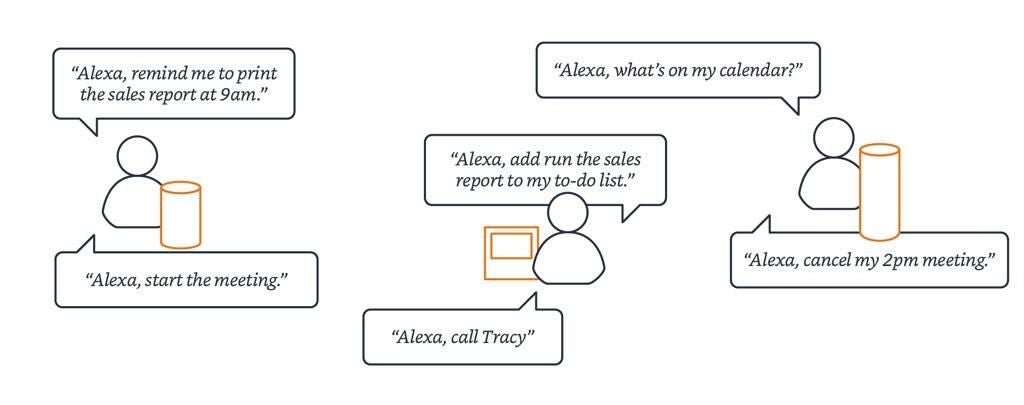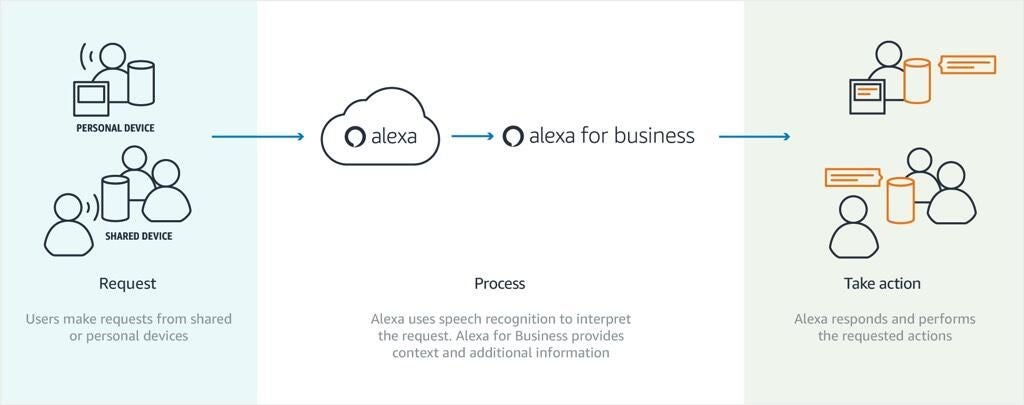Alexa is on the way to work.
Amazon’s Alexa for Business service aims to give your conference rooms and your desk a much better interface for connecting to meetings, calendars, tasks, and company data.
The Amazon Echo has brought the Alexa voice assistant to over 20 million homes around the world. It’s made it easier for people to set timers in the kitchen, turn on lights throughout the house, play their favorite songs and order household supplies–without ever touching a mouse, a phone or a physical switch or button.
“If voice is the natural interface for dealing with things in your home, why not do it at work,” said Amazon CTO Werner Vogels in announcing Alexa for Business at the 2017 AWS re:Invent conference.

Image: Amazon
SEE: More TechRepublic cheat sheets and smart person’s guides
What is Alexa for Business?
After leading a breakthrough in consumer adoption of voice control interfaces, on November 30, 2017 Amazon announced that it was integrating the Echo platform into the office with the launch of Alexa for Business.
Some of the things that Alexa for Business is capable of doing via voice control include:
- Look up events
- Manage your schedule
- Manage your task list
- Read and respond to emails
- Set reminders
- Find an open meeting room
- Book meeting rooms
- Provide directions to a conference room
- Initiate calls in conference rooms
- Join virtual meetings
- Control conference room equipment
- Notify facilities about a problem with the building
- Alert IT to a technology issue
- Order office supplies
- Query databases and reports
- Access your latest sales data
- Check inventory in warehouses
Some of the solutions that work with Alexa for Business include:
- Amazon Chime
- Cisco
- Polycom
- WebEx
- Zoom
- BlueJeans
- Skype for Business
- Microsoft Office 365
- Microsoft Exchange
- Google G-Suite
- Salesforce
- Concur
- ServiceNow
- Splunk
- RingCentral
- Vonage
- Tact.ai
But, Amazon doesn’t just offer companies the ability to place a bunch of Alexa devices around the office. It has an enterprise-level security and manageability model. It also has enterprise deployment tools that allow IT to set up hundreds or thousands of shared devices without having to manually configure each one.
SEE: How to become an Alexa developer: A cheat sheet (TechRepublic)
There are also user enrollment tools for employees to sign up to work with the company’s shared Alexa devices, and there’s the opportunity for an employee to carry over their personal Alexa skills and preferences–to play their Spotify playlists at their desk, for example. Enrollment works both ways, too: Users who’ve signed up can access Alexa for Business skills from home as long as they have an Alexa-capable device.

Image: Amazon
How can Alexa for Business transform the workplace?
Connecting to video conferences or online meetings and getting PowerPoints to work in conference rooms are still touch-and-go, even though IT has been trying to streamline them for decades. If Alexa for Business can pull off the scenario where an employee walks into a meeting room and simply says, “Alexa, connect to my 2:00pm conference call” and it just works, then it would be a big win in many organizations.
That would be enough for a lot of enterprises to adopt Alexa for Business. However, Amazon’s ambitions for the service are a lot bigger than that. If you watch the company’s promo video for Alexa for Business, you can see that the company is not just proposing Echo devices in the conference room, but also in hallways and public spaces throughout corporate buildings. But above all, Amazon is envisioning an Echo device on every desk so that employees can use their voice to streamline basic business functions and multitask.
SEE: Alexa for Business likely to win in smart office, leverage AWS, Echo, developers and consumers (ZDNet)
The biggest challenge with Amazon’s vision is that so many companies have been moving to open concept workspaces. The Alexa-on-every-desk strategy won’t work in that environment because one wake-word could set off a ton of devices at once. It could also be considered impolite and disruptive to be talking with Alexa and getting audio feedback in an open environment, since it could distract your neighbors.
A potential workaround for utilizing Alexa in an open office setting would incorporate the use of Amazon’s Alexa-powered wearable devices. The Echo Frames smart glasses and Echo Buds are both capable of activating Alexa using touch or hand gestures instead of voice activation. This could eliminate the issue of activating the wrong device, and it could reduce distractions when receiving Alexa’s feedback.
Alexa for Business also has the potential to be a valuable asset for remote workers and distributed businesses. During the COVID-19 pandemic, it announced new hands-free integrations with Zoom Rooms and Lifesize, and user enrollment features mentioned above give businesses a chance to extend office functionality into the homes of their employees.
As the business world settles into a post-pandemic reality, the likelihood of hybrid and remote work remaining is high, which means Alexa for Business has the potential to become a permanent fixture both in offices and homes across personal devices and shared ones.

Image: Amazon
What types of organizations should consider Alexa for Business?
For organizations that are trying to create smart offices to increase productivity, the opportunity for Alexa to streamline conference calls, virtual meetings, and presentations could make Alexa for Business an important pillar in a digital transformation plan inside the office.
For professionals who are already happily integrating Alexa into their homes, the chance to use it to do similar voice-activated tasks at work could make it an easy transition–similar to how many companies have integrated iPads.
SEE: How to optimize the smart office (ZDNet special report) | Download the report as a PDF (TechRepublic)
And for workers who have offices–or private workspaces with ample space–the opportunity to put Alexa on your desk at work and manage tasks, calendars, reports, meetings, and reminders, could be a natural productivity enhancer.
On its Alexa for Business site, Amazon has cited several companies that have already piloted the service and seen results (you can read their comments here):
- BMC
- Brooks Brothers
- Capital One
- Mitsui & Co.
- Vonage
- WeWork

Image: Amazon
How can you get Alexa for Business?
Alexa for Business is part of the company’s Amazon Web Services division, so it works off a similar pricing model to SaaS. It’s pay-by-service with no upfront costs or contracts. You’ll have to pay for the Alexa devices separately. If you are purchasing 250 devices or more, there’s the potential for discount pricing. In that case, you reach out to your AWS sales representative or fill out a form on the AWS sales site.
SEE: Alexa for Business: 10 key takeaways (ZDNet)
With the Alexa for Business service itself, enterprises get management and deployment tools and the SaaS middleware to make it all work together with partner platforms like Microsoft and Cisco.
Companies pay in two different ways, according to Amazon’s official pricing:
- Shared devices — “You can deploy Alexa devices to shared spaces in your workplace like conference rooms, huddle rooms, phone booths, lobbies, and copy rooms. Shared devices are not linked to any specific user, and anyone with physical access to the device can use them… Each device is managed and configured directly through the Alexa for Business console, where you can set the location, specify which skills to make available, and enter conference room settings.”
- Enrolled users — “You can invite end users to enroll their personal Alexa account with your Alexa for Business account. This lets them use the Alexa features and skills that they’ve already enabled on their account, as well as any private skills you make available through Alexa for Business. They can use these on all the devices associated with their personal Alexa account, including their devices at work, in their homes, or through the Alexa app on their mobile phone.”
Amazon sees companies using both scenarios, and the following is an example of what the pricing could look like in that case:

Image: Amazon
SEE: IT leader’s guide to the future of artificial intelligence (Tech Pro Research)
But if a company doesn’t want to enroll any users and just wants to use Alexa for Business in conference rooms, then that’s fine, too. The AWS invoice would look like this:

Image: Amazon
Those that have signed up, or are looking for more information about the entire system should check out the getting started portal Amazon created for Alexa for Business. It includes a number of resources including set up and user enrollment steps, as well as API guides and Skills Kits for businesses that plan to develop their own in-house Alexa skills.
SEE: The Future of Everything as a Service (a ZDNet/TechRepublic special report)
Keep in mind that all of this is powered by AWS, which increasingly looks like “Your-Entire-Enterprise-as-a-Service.” Also remember that voice assistants like Alexa are a rudimentary form of artificial intelligence and machine learning. So, we should ultimately think of Alexa for Business as one of Amazon’s early plays at bringing powerful AI services to the corporate world.
At AWS re:Invent, Vogels even admitted, “Voice is the first disruption that will happen, driven by this machine learning platform that we’ve given you.”






